
This chapter invites awareness of the beings we share the planet with, the soil beneath our feet and the cycles of life. The very essence of permaculture is connection with nature and using nature as our teacher and guide. We need earthcare solutions as much as we need peoplecare solutions. A step towards finding ways of regenerating natural systems is to feel ourselves as part of the Earth.
Joanna Macy and her colleagues have been developing this work over the last few decades. As the name suggests its purpose is to reconnect us; to ourselves, each other, and the Earth; to the joys and pains of life in this time; to our personal and collective responsibilities; to our ancestors and future generations; and to our power to make a difference and heal the planet. Through opening up and discovering these connections we can start to engage with shared wisdom, our internal skills and resources and feel our potential for transformation.
The disconnection we have allows the harm to continue; when we connect there is opportunity for healing.
It is the work that needs doing to make the inner transition and facilitate the Great Turning. It is ‘work’ because it doesn’t come naturally, we have to focus on it. It comprises four stages. I would encourage you to complete the sequence of four activities given here. Many more activities can be found in the book, Coming Back to Life.1
Being alive in this world is a miracle in itself. To have before us and within us the skills and resources to participate in the Great Turning is something to be thankful for. Centering our attention firstly on gratitude provides the base for the work to come. This foundation strengthens us to face up to the pain we feel. This phase breaks us away from the moulds of complaining, victim and blaming attitudes that are prevalent in our societies. It opens our heart and allows us to express love.

Imagine holding this jewel of a planet in your hands. From this distance you can see the swirling global weather patterns, the great expanses of ocean and the contrasting textures and colours of the land. You can feel the perpetual motion.
Peering closer you can see your country; its outline and edges with other countries and the sea. Focus in on the bioregion in which you live. Coming closer still you start to see the movements of people and marvel at the intricacies of animals and plants.
You can see the place you live, the people that surround you and the activities that are happening. Appreciate the amenities you have access to, your friends and family and neighbours. Take a moment or two to feel full gratitude for your place in the world.
Now slowly take your awareness back out to the bioregion, and then the country until you are once more looking at this shining jewel of a planet in your hands. Once again feel the wonder and awe of the beauty and complexity of the Earth.
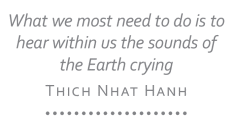
How do we feel the world crying around us, beneath us, within us? We all have feelings associated with the devastation and injustices we are witnessing in the world. Many of us prefer not to face those feelings and are in denial; they can be too painful, too sorrowful. But it takes energy to suppress these emotions.
Caring means to notice the troubles and pains of people and the planet. When we own these feelings inside of us, we are allowing ourselves to hear our inner voice. Anger and pain can be used in positive ways; we can channel these feelings into action for change. We connect with our own personal feelings. All of them are valid; there is no right or wrong.
When we unblock the feelings of pain we also unblock the feelings of love and joy we can experience. We can avoid burnout and despair through processing our pain rather than suppressing it.
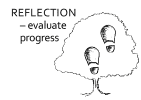
When you read about the global problems at the beginning of this part, feelings probably arose, although you may not have paid specific attention to them. Have a look back and then find a way of expressing these feelings symbolically. Painting, drawing or playing with clay or stones may call you. It doesn’t need to be a great work of art; this is for you not for anyone else. It may just be an angry scribble that comes.
We are all connected to each other and to the whole of life. The concept of separation our culture clings to is an illusion. We do not have the capacity to see how we affect the world and the ripples our actions have into the future. Our very presence has an effect; we cannot take ourselves out of the equation. We are in a massive loop of interconnectedness with all parts of the universe. It all matters, it’s all important. When we realise this fully we see the world and ourselves differently.


Look at your hands, your palms showing the lines of your life, your fingers with all their sensitivity to touch. Fingernails, painted red or with soil beneath them. The backs of your hands, so familiar to you. Think of all the things you have done today with your hands.
Now think about all the hands around the world and the actions they are doing at this moment in time. Imagine a woman in Uganda holding her child tight in her embrace. A boy in Spain playing with his friends, catching a ball. Think about the hands working in a factory in Taiwan. Hands eating rice in India, picking apricots in Turkey, weeding in America, holding a cup of tea in Scotland. Think of a hunter with his hands on his bow and arrow in the Amazon.
And think about those whose hands hurt at the moment, hands out of action, healing in a plaster cast. And those without hands who have learnt to use their feet or mouths to paint amazing pictures.
A baby’s hands reaching out for a toy for the first time. Hands waving goodbye to friends. Hands held in prayer.
We are all as one in our shared humanity.
The final stage is to move our anger and our love through into action. To take these energies to empower us into what we can do. When we are in touch with our feelings we can be our authentic selves and we can reconcile our pain with being human and connect with the whole of humanity.
With this stage we find direction for our changes. We can find strength in self-organisation and connect with like-minded people. We can create change together and speak out for injustices.
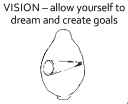
What is my positive vision for humanity?
What role can I play in achieving this vision?
Too often nature can be seen as a background to our human existence. Or even worse, just something to exploit, dominate, or overcome; other species are for food, medicine, working for us, or a nuisance or pest. The underlying assumptions of some major religious views are that humans are the pinnacle of creation and in some way superior and separate from other species. Deep ecology is a term coined by Arne Naess in the 1970s challenging this belief. It is a simple idea that has far reaching implications. There are two main strands: firstly we are part of nature not separate, and secondly, every species has an intrinsic right to exist beyond its use to humans. This effects how we maintain habitats. In contrast, politicians and scientists have been heard to talk about planetary limits to the amount of biodiversity we can ‘afford’ to lose. I have heard a politician consider how much it would cost for us to replace the work of pollination if bees were to become extinct. The deep ecology view is that we can’t afford to lose any species.
If we are looking to other species and only valuing them for their worth to us, is this also a mirror of how we look at other people? Do we perceive other people in relation to their usefulness? How can we move to valuing all people and all species for their intrinsic value?
To give voice to the brother and sister species that we share the planet with, Joanna Macy and her colleagues devised an activity known as the Council of All Beings. I participated in a Council in summer 2010 and found it a deeply moving experience. Here is our story:
“After settling into the weekend with exercises to reconnect with ourselves and the pain we felt for the world, we moved into preparations for the Council. We began with a silent contemplative walk on the land alone, asking to be shown which species we were to represent. We opened up to owl vision, and practised walking like foxes.
I sat by a stream in a dreamlike, meditative state, listening to its babbling chatter. I was not sure why but the thought of being a salmon came to me, I did wonder if maybe I would be something else but still the answer was to be a salmon. Wandering back through the fields my thoughts settled into the landscape.
My friend’s walk led her to follow tracks of the cows escaping from their usual confines and acting as wild animals free to choose their own path. She tuned into the cow’s walk out of the fields through some wild and muddy places next to the river not normally walked by humans. She had a glimpse at their experience, not as a farmer’s property fenced in, but as a wild animal following its instinct to find food.
When we had found our beings we returned to the barn where there was a hive of silent activity as masks of our beings were made with leaves, sticks, ribbons, card and paint. We proudly wore our masks to process down to the tipi, leaving our human identities behind. Once inside the tipi, the Council began and we spoke of how it was to be alive now and our experiences of the world we live in. There were no humans present, but they were often mentioned as each of our lives were impacted by them.
Cow, snow leopard, river, owl, bee, stream, slug and mole were present alongside my salmon. We spoke of our homes and food sources being lost; of the cruelty and killing; of being caged and poisoned. The cow expressed her sadness and distress of not being given the space she needs, and of having her calves taken from her and slaughtered. But she had an air of forgiveness and hope that humans and cows could relearn to live in harmony as they have done for thousands of years, and optimism for the future of all beings. The mole said that it had never seen a human and was only dimly aware of them; a reminder to us people that perhaps we are not as central as we think, and maybe overestimate our importance. The river spoke of being polluted and the stream of being depleted. The bee said it couldn’t breathe because of what the humans are spraying, it talked of working closely with humans and providing for them and yet being taken for granted.
We spoke of our disbelief at human actions; we were not able to understand why they choose to act in this way. Behind the painted masks tears flowed as we experienced the pain of our brother and sister beings.
That evening we brought our masks to the fire to ceremonially burn, releasing their voices and wisdom. Their voices were within us now. Before we said goodbye to them, they shared with us a message of their strengths for us to use on our journeys. We were again reminded that each being holds its own wisdom, and we can learn from each one. There are understandings and insights beyond our human perspectives.
The salmon’s message to me was to follow my own path, travel with like-minded beings and work together, accept that sometimes you have to travel up stream and remember to take great leaps.
The mole’s message was to look beneath the surface to find deep meaning and sense without our eyes. The mole represented the unseen forces at work all the time. These forces could be destructive, such as unpredictable reactions in ecosystems or could be healing and the Earth may be healing itself in ways that we don’t know about. Things could be much better or worse than we humans see.
The bee’s lesson was about community; we can achieve so much if we work together, things that would be impossible alone; and that we must do that work in love, to serve the wider community and when our work is done in this way it is a joyous affair – not like work at all. As humans we need community, a hive to be a part of to give us companionship and a sense of purpose in our lives.
It felt like there was value to be had in giving voice to the grief, anger and despair that arose in the Council, and in listening with good intent to the wisdom of the beings present.
We went to bed with the sound of owls hooting and the river bubbling to dream of wild places.
The next day someone phoned saying they had caught a swarm of bees and wanted to bring them to the empty hives on the land where we were staying. After hearing of the troubles of honeybee in the council, it felt like a fitting blessing to have 30,000 bees arrive to end the weekend.”
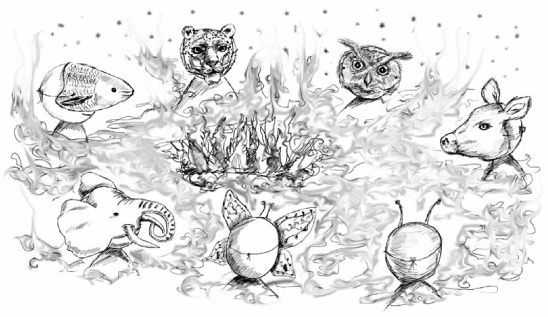

Permaculture has arisen from the study of nature and the drive to understand its principles at work. Its roots are deeply embedded in the respect and observation of wild places. Its fruits are profound connections with nature, creative approaches to gardening, a move away from chemicals on the land and empowerment of individuals and communities. There is a new branch growing in the permaculture tree where we draw upon this knowledge of natural systems to bring it into our personal and social systems.
When we learn from nature we build respect and tune into bigger processes and time frames. We are nature ourselves and have natural processes occurring within us and between us, so understanding nature helps us to comprehend ourselves better. Following natural patterns and principles can increase our health and real wealth and decrease our stress. Spending time in nature promotes harmony between the planet and us.

We can learn how to align ourselves with natural rhythms – daily, seasonally, annually and over much larger timescales. We can think about annual cycles in our own lives: what were we doing when we harvested the blackcurrants last year? We can find the rhythm and pulse to our actions. Within all natural systems are cycles of birth, growth, death and regeneration. Each plant and animal has phases of development. We can tune into the characteristics of the seasons for our own phases of development: times of shedding leaves and letting go, times to grow and times to rest, time for reaching out and times for reaching in.
Animals and plants have different paces of life to our own. Some have a lifecycle shorter than our working day, whereas trees are here for hundreds of years, watching life change around them. The trees we plant now could be there for our great, great, great grandchildren. What can we learn from the slow moving snail, or the buzzing bee? We can break away from our human perceptions of time and movement and see beyond to vast wealth and diversity in being.
I stopped on the moors to watch the free-living horses and they came over to my car to use it as a scratching post. Animals are expert permaculturists, they adapt to what is there, use niches as they appear and any available resources. A jay has just landed by the window to collect an acorn it had buried there, he knows how to catch and store energy.

When we look at whole ecosystems we can focus on the connections and interdependencies. We can look to individual species and wonder how they relate to the other species around them. What is their part to play in the web of life? How do all of these species function together sustainably? What are the unique gifts each species have that enable them to adapt to their surroundings?
These questions stimulate us to think more deeply about what is going on in the world around us. Nature’s rich diversity provides us with bountiful opportunities to expand our thinking beyond our human constraints.
Permaculture originated with looking at the principles of ecology and asking how nature is sustainable. Through beneficial connections, energy cycling, producing no waste, diversity and interdependencies ecosystems are resilient with high output and low input. Bringing these principles and patterns into our designs we can emulate nature.
Biomimicry asks how nature achieves things. We could look to nature and ask questions relating to the three ethics.
For earthcare – how does nature purify rivers, deal with waste and break down oil spills? How does nature restore soil and recolonise barren land?
For peoplecare – how do animals care for their young? How do animals find their own healing plants in the hedgerow? How do they communicate with each other? What behavioural patterns can we find useful in our groups?
For fair shares – how does nature live within limits? How does nature create abundances? How do predator and pest populations maintain a balance over time with each other?
Connecting with nature is more than just an intellectual process. Being in nature is a whole body and mind experience. As young children we have no concept of nature being different from us, we are just constantly experiencing and learning from the world around us, and our connection to it. This wholeness needs to be maintained or the idea of nature as something separate comes in.
In some cultures children receive a passive but direct education of nature. They learn through their hands the realities of working the land with their parents.
It can be more of an active education in other cultures. A deep spiritual connection with nature is fostered, perhaps with initiation rituals. Stories and myths are used to reinforce and deepen understandings.
In other cultures, particularly in the Western world, there is an absence of any kind of teaching about how to connect with nature. Some children will have the fortune of growing up with access to nature to play in and explore and create their own relationship with. Others sadly miss even this.
Lusi Alderslowe has set up a ‘nurture in nature’ group in Glasgow, Scotland, where parents and children gather in nature to play. Whatever the weather they meet in city parks or green spaces accessible by bus or train. By being in nature their children have opportunities to meet their needs of organic and free play. They bring no toys with them; the children play with each other and create games in nature. Climbing trees brings them connection and understanding in ways that climbing frames can’t. By being out in rain, wind and snow they learn to read weather patterns and feel alive. The group has had the added side effect of encouraging the parents to connect and learn from nature as well. For both parents and children the group meets all nine of Max-Neef’s needs for subsistence with eating lunch together; protection with parents present; affection for nature and other people; understanding of nature; participation in a group; leisure and creation by creating toys and games in nature; identity as part of the group and freedom with space to run around.
The simplest way to learn from nature is by just being in nature. By being present and open we can absorb through our pores the essence of natural life, we become aware of our own nature. We can take a step to more active learning with observation exercises, designed to open the curtains to new ways of sensing the world around us. If we have questions in our lives we can take time in nature, allowing answers to emerge from our observations.
In the Council of All Beings each being gave us a message – a metaphor to use in our lives. Metaphors bring in our subconscious and intuitive knowledge of nature’s rhythms, cause and effect and cycles of life. The following activity invites nature to share metaphors for our lives.



Take a walk in nature. For the first 10 minutes of the journey think about your past, notice what is stimulated, what is called to mind? Let nature inform you, find the metaphors for your past in nature and the world around. Perhaps you see a bramble thicket that reminds you of a thorny time in your life that bore fruit. The choices you make on the walk are informative. Where does your awareness go, inwards, outwards, up, down, into the detail, or out to the periphery?
Focus on your present life for the next 10 minutes.
The last 10 minutes is time to spend thinking about your future. Again think about what nature is showing you. Are there animals or insects that cross your path? What are the clouds doing?
It feels appropriate that we come full circle into the garden, as our permaculture heritage is from there. In the garden we are able to meet the ethics of peoplecare, earthcare and fair shares. It is the place where the ethics, principles and design all fall into place and get woven into our intuition and the wisdom of our hands. It is where we can understand the connection between our own health and planetary well-being. It is the place of optimism, growth and abundance.
The garden is the meeting place for us and other beings. When involved in gardening, farming and woodland management we are actively participating in the conversation with nature. As with all conversations we need to be able to listen and respond appropriately. This active, first hand learning with nature is profound.
Permaculture gardening focuses on integrating useful and edible plants with maintaining and increasing wildlife habitat in a low maintenance way.
Gardening is an integrating activity in itself, stimulating all aspects of personal health. Through exercise, fresh air and wholesome food we improve our physical health. The wonder and satisfaction of growing our own food increases our self-esteem and our emotional health. Planning and designing our garden or window boxes requires some mental agility and flexibility. Connecting with nature and the life cycles of birth and death maintains our spiritual well-being. The food feeds our body and the process of gardening nourishes our soul.
The garden is one of the easiest places to create abundances, and to be witness to the profusion of nature. Gardeners can create surplus to share with neighbours as well as for insects and feathered friends. Many people come to permaculture to improve their gardens or growing spaces and start to change themselves. Other people change their inner landscape leading them into the garden. Inner growth is reflected in outer productivity.
Gardening helps us to be in touch with the realities of life. We are encouraged to think holistically and learn with our hands and senses, not just our head. We can break through the destructive assumptions of separation through our physical contact with the soil.
Gardening can be inclusive of the whole family and can also be a community activity. The garden can be the classroom, playground, store cupboard, meditation room, gym, office and wilderness.
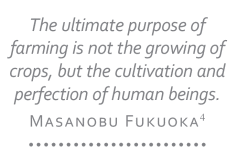
There are many informative books on gardening so I won’t go into methods of creating a permaculture garden. I will just share my top tips for enjoying gardening:
Children are the future. The most effective way of ensuring the future of the planet is by cultivating the next generation of gardeners. From the moment we are born our learning begins. As nature is the greatest teacher it makes sense to fully integrate children into the experience of growing as they themselves grow and develop. Observation of nature leads to a deep understanding and respect, the foundation for restoring harmony with nature.
From a very early age children can develop an interest in gardening that can hold them in good stead for the rest of their lives. The processes learnt in the garden are valuable transferable tools whatever direction their lives take. Gardening can have as profound an effect on children as adults; they can feel empowered by growing their own food and grounded by their connection with the earth. A school garden can serve many of the purposes of education.
Interest is sustained if it’s made fun and enjoyable. Yields that they enjoy from the garden are motivating. Correct harvesting can teach them about the use of resources and not being too greedy and taking so much that the plant cannot recover. Having their own garden jobs can help them to learn responsibility and the consequences of their actions. If they look after the plants then they grow and are abundant, if they don’t, then the plants wither and die. These lessons can be expanded out into a wider systems view of relationships with the world.
With their sense of wonder in the world, children’s observation and questioning skills are often much more heightened than adults’ who may take the world and nature for granted. Children are amazing resources with their imagination and creativity. With patient and thoughtful design, their unlimited curiosity and enthusiasm can be harnessed and channelled into happy, productive activity.